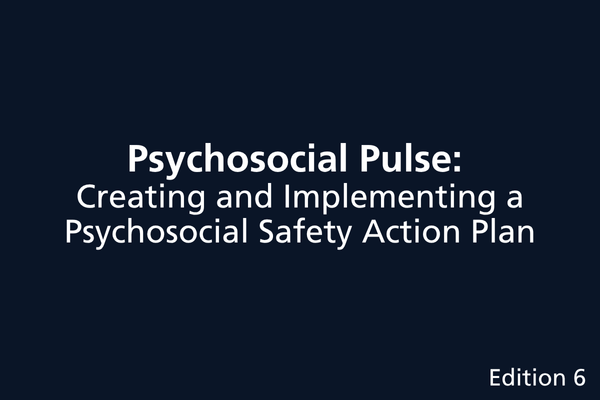Over the past five editions, we’ve explored the key elements of psychosocial safety in the construction industry—from leadership and culture to training, engagement, and compliance. Now it’s time to bring it all together.
This final edition provides a practical guide to developing and implementing a Psychosocial Safety Action Plan—a clear, site-ready strategy that ensures psychosocial risks are managed proactively, legally, and effectively.
Why an Action Plan Matters
In the construction industry, where physical hazards are well-managed through systems and procedures, psychosocial risks often remain invisible and unaddressed. A Psychosocial Safety Action Plan bridges that gap—it transforms good intentions into structured, measurable action.
A psychosocial safety action plan helps construction leaders:
- Translate awareness into action
- Meet WHS and Fair Work obligations
- Create consistency across teams and projects
- Build a culture of trust, wellbeing, and performance
- Monitor progress and continuously improve
But for it to work, it must be actively implemented—not just filed away.
Here’s why it matters:
- It turns compliance into culture
Legal obligations under WHS and Fair Work require employers to manage psychosocial risks. But a documented plan goes beyond ticking boxes—it embeds wellbeing into the daily rhythm of site life, making it part of how work is done, not just what’s written in policy.
- It protects your people and your business
Unmanaged psychosocial hazards—like stress, fatigue, bullying, or isolation—can lead to absenteeism, turnover, poor morale, and safety incidents. A proactive plan helps prevent these issues, reducing risk, protecting revenue and improving productivity.
- It builds trust and transparency
When workers see that leadership is serious about mental health and wellbeing, they’re more likely to speak up, seek help, and support each other. A clear plan shows that you’re not just talking about safety—you’re acting on it.
- It creates consistency across teams and projects
Construction sites vary in size, scope, and crew composition. A standardised action plan ensures that psychosocial safety is addressed consistently, regardless of who’s on site or what phase the project is in.
- It supports continuous improvement
With built-in review and monitoring processes, your plan becomes a living document. It evolves with your site, your team, and your business—helping you stay ahead of emerging risks and changing workforce needs.
Developing the Action Plan: Step-by-Step
- Leadership Commitment
- Identify leaders and supervisors to champion psychosocial safety.
- Communicate the importance of mental health across all levels.
- Allocate resources (time, budget, training) to support implementation.
- Risk Identification and Assessment
- Use surveys, interviews, and incident data to identify psychosocial hazards.
- Assess risks based on likelihood, severity, and frequency.
- Prioritise risks and document findings.
- Worker Engagement
- Consult with workers and HSRs during planning.
- Invite feedback and ideas for improvement.
- Ensure representation from different roles and crews.
- Control Measures
- Develop practical strategies to reduce or eliminate risks.
- Include training, supervision, workload management, and peer support.
- Tailor controls to site conditions and workforce needs.
- Policy and Procedure Development
- Create or update policies on mental health leave, respectful behaviour, reporting concerns, and return-to-work.
- Ensure policies are accessible and consistently applied.
- Clear Communication and Reporting Systems
- Establish confidential channels for reporting psychosocial concerns.
- Train supervisors to respond appropriately and escalate when needed.
- Use toolbox talks, posters, and digital platforms to reinforce key messages.
- Monitoring, Review, and Continuous Improvement
- Set review timelines (e.g. quarterly or post-incident).
- Track metrics like absenteeism, engagement, and incident reports.
- Use feedback and data to refine strategies and update controls.
Embedding the Plan into Daily Operations
To ensure the plan becomes part of your site culture:
- Toolbox Talks: Include a short wellbeing message or psychosocial safety tip in every pre-start meeting. Rotate speakers to encourage participation.
- Supervisor Check-Ins: Encourage informal wellbeing check-ins during breaks or task transitions. Use open questions like “How’s the workload feeling today?”
- Visible Resources: Display posters with contact details for support services (e.g. TIACS, Menslink, Beyond Blue, EAPs) in lunchrooms and site offices.
- Peer Support Roles: Nominate crew members as wellbeing champions or peer support contacts. Provide basic training and recognition.
- Feedback Channels: Use suggestion boxes or digital forms to collect anonymous feedback on site culture, stress levels, and improvement ideas.
- Incident Debriefs: After any critical event, include a psychosocial debrief to check on emotional impacts and offer support.
Suggested Training Modules for Worker
To build capability and confidence across your team, consider these training modules:
- Mental Health Awareness for Workers
Recognising signs of stress, anxiety, and burnout; how to support a mate and seek help.
- Emotional Intelligence for Supervisors
Active listening, empathy, and conflict resolution; managing performance with compassion.
- Resilience and Stress Management
Coping strategies for high-pressure environments; building personal and team resilience.
- Peer Support and Suicide Prevention
Training workers to identify and respond to mental health risks, creating a peer-led support network.
- Psychosocial Risk Management for Leaders
Legal obligations under WHS and Fair Work; developing and reviewing psychosocial safety plans.
Conclusion
Creating and implementing a psychosocial safety action plan is the final step in building a mentally healthy construction workplace. It brings structure, accountability, and clarity to your efforts—and ensures your team is supported, your risks are managed, and your business is protected.
This week’s reflection for business owners and supervisors:
- Is your psychosocial safety plan active and visible on site?
- What’s one step you can take this month to embed it into daily operations?
If you have any questions or need further guidance, please don’t hesitate to contact our Workplace Relations team:
📞 (02) 6175 5900
📧 workplace@mba.org.au
